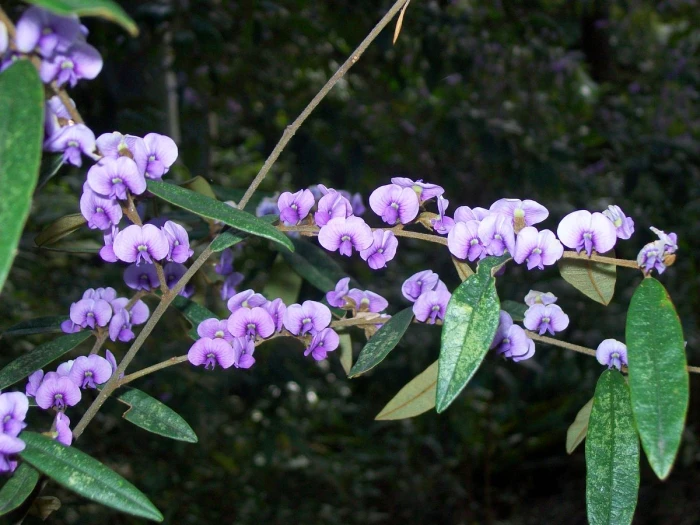Lance Leaf Hovea
(Hovea lanceolata)
Lance Leaf Hovea (Hovea lanceolata)
/
/

Poyt448 Peter Woodard
CC0
Image By:
Poyt448 Peter Woodard
Recorded By:
Copyright:
CC0
Copyright Notice:
Photo by: Poyt448 Peter Woodard | License Type: CC0 | License URL: http://creativecommons.org/publicdomain/zero/1.0/deed.en | Uploader: Poyt448 | Publisher: Wikimedia Commons | Title: Hovea_lanceolata_flowers_&_leaves.jpg | Notes: {{Information |Description=Hyacinthoides non-scripta (Common Bluebell), taken Forrest, Hertfordshire, UK |Source=Own photo |Date= 28 April 2007 |Author=Self: Commons user [[User:MichaelMaggs|MichaelMaggs]] }} == Licensing == {{self|cc-by-sa-3




Estimated Native Range
Climate Requirements
| • Precipitation | 19" - 65" |
| • High Temp. | 73°F - 97°F |
| • Low Temp. | 28°F - 66°F |
Summary
Hovea lanceolata, commonly known as Lance Leaf Hovea, is an evergreen shrub native to the sclerophyll forests and coastal heaths of Eastern Australia. It typically grows to a height of 2-6 feet and can spread up to 5 feet wide. The plant features narrow, lance-shaped leaves and is adorned with vibrant purple pea-like flowers during late winter to early spring, which are highly attractive to bees and other pollinators. The flowers are considered showy, making it a desirable ornamental species.
Lance Leaf Hovea is valued for its hardiness and the year-round interest it provides in gardens due to its evergreen foliage and winter flowering habit. It is often used in native plant gardens, as a border shrub, or for informal screening. This shrub thrives in well-drained soils, tolerates a range of soil types from sandy to loamy, and prefers a position with full sun to part shade. While it is drought-tolerant once established, it benefits from medium watering, especially during extended dry periods. It is generally low-maintenance but can be susceptible to root rot if overwatered or planted in poorly drained soils.CC BY-SA 4.0
Lance Leaf Hovea is valued for its hardiness and the year-round interest it provides in gardens due to its evergreen foliage and winter flowering habit. It is often used in native plant gardens, as a border shrub, or for informal screening. This shrub thrives in well-drained soils, tolerates a range of soil types from sandy to loamy, and prefers a position with full sun to part shade. While it is drought-tolerant once established, it benefits from medium watering, especially during extended dry periods. It is generally low-maintenance but can be susceptible to root rot if overwatered or planted in poorly drained soils.CC BY-SA 4.0
Plant Description
- Plant Type: Shrub
- Height: 2-6 feet
- Width: 2-5 feet
- Growth Rate: Moderate
- Flower Color: Purple
- Flowering Season: Winter
- Leaf Retention: Evergreen
Growth Requirements
- Sun: Full Sun, Part Shade
- Water: Medium
- Drainage: Medium
Common Uses
Border Plant, Low Maintenance, Rock Garden
Natural Habitat
Sclerophyll forests and coastal heaths
Other Names
Common Names:
Scientific Names: Hovea lanceolata, Hovea longifolia var. lanceolata, Hovea lanceolata var. linearis
GBIF Accepted Name: Hovea lanceolata Sims